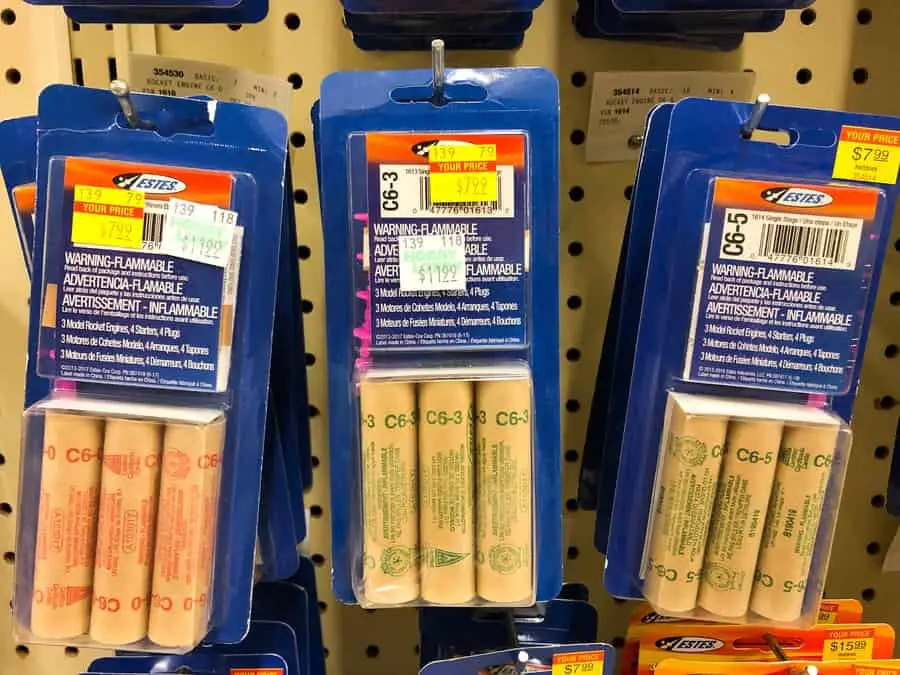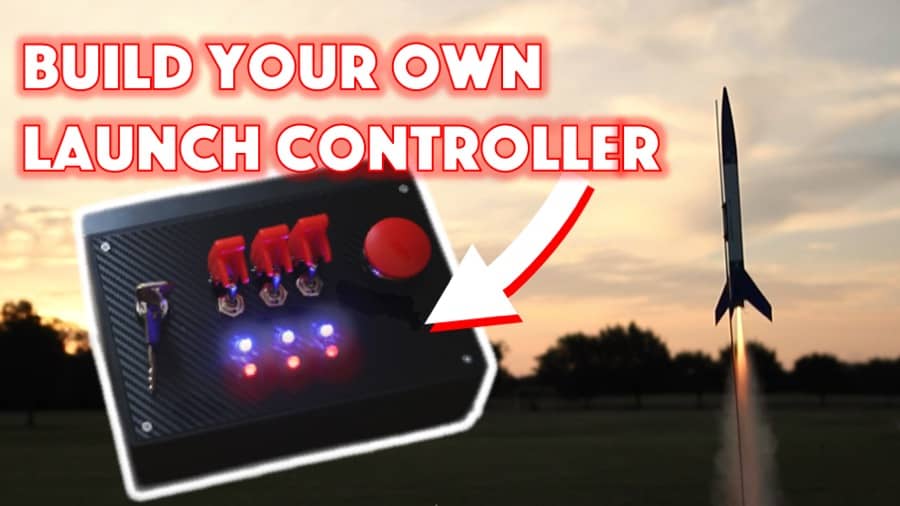
One of the great benefits of model rocketry is that most of the components are reusable. Rockets you build can be launched over and over, year after year. One of the components that isn’t reusable however, is the rocket engine itself. Not only is it not reusable, but unlike other components of the rocket, it does have a shelf life. So how long do model rocket engines last?
Basic Estes rocket engines can last for several years (or longer) in proper storage. Environments with high humidity and fluctuating extreme temperatures (32˚F to 140˚F) will decrease this shelf life. The shelf life of homemade engines varies as the chemical compounds in the recipe vary.
In this post we’ll cover the shelf life of typical Estes rocket engines, homemade rocket engines, and also provide a resource on how to dispose of expired rocket engines.
DISCLAIMER: THIS ARTICLE IS BASED ON OUR RESEARCH AND UNDERSTANDING BASED ON THE INFORMATION AVAILABLE TO US. ALWAYS EXERCISE EXTREME CAUTION WHEN DEALING WITH COMBUSTABLE MATERIALS AS THEY ARE HAZARDOUS. YOU ARE RESPONSIBLE FOR THE SAFE HANDLING AND PROPER/LEGAL DISPOSAL OF HAZARDOUS MATERIALS.
Are you still using the standard Estes controllers for your launches?
We just built our own beautiful launch controllers that make launches SO much more fun, and we documented EVERY single step and item purchased and put it into a step-by-step course that teaches you how to do the exact same thing.
Click here to learn more about how you can build your own launch controllers!

About Model Rocket Engines
The model rocket motor, also known as the “engine” or “propellant,” is the power source of the rocket, consisting of a fuel-and-oxidizer mixture (this solution is the actual propellant). The propellant mixture works along with a “blow-burning delay cap,” and a black powder which is used as the ejection charge. All of these components are packaged together in a casing of paper, aluminum, or plastic. (For related reading, see our other posts on “How do model rocket engines work?” and “Model rocket engine sizes and classifications”)
Homemade rocket engines are quite similar to commercial engines, believe it or not (there are some key distinctions, of course)! The propellant is ignited through the nozzle and burns all components on the entire inside surface of the casing. This burning produces hot, pressurized gases, which are then forced through the nozzle, creating the force needed to launch the rocket.
With regard to the shelf life of model rocket engines, their longevity can be altered by the type of motor and storage environment. Black powder engines are more susceptible to being damaged by environmental factors than composite engines. Homemade engines are even more susceptible as they are not usually made under the best conditions or with the best materials.
Can a Model Rocket Engine Expire?
It’s important that you remember that, in the proper storage environment, some model rocket engines do not expire for several years! The Estes Rocket FAQ page even says that their engines “do not have a shelf life” as long as they are stored in a cool, dry place. There are even reports of people flying black powder model rockets that are over 30 years old. (Not recommended!)
Storage is key. You can keep your model rocket engine as long as you need as long as it is stored in a cool, dry area, and protected from humidity and fluctuating, extreme temperatures (“extreme” being 140˚F and 32˚F).
It is best to keep the engines in the original packaging for as long as possible. This packaging is designed to keep the rockets shelf stable for a long time.
Before flight, you should be in the habit of inspecting your engines whether they are old or not. Look out for any signs of damage, any bulging or loosening of the casing, and rust or deformation of the nozzle. If something looks off with the engine, it mostly like is, but even if it looks fine, there could still be internal issues with engine.
Storing Liquid Propellant
Liquid propellants are made up of a fuel and an oxidizer (i.e. gasoline and liquid oxygen). When ignited, the gases created by the combustion of a liquid propellant engine will be forced through the nozzle at speeds between 5,000-10,000 mph.
Chemical mixtures of liquid propellants can include any dual combination of the following: liquid hydrogen, liquid oxygen, gasoline, kerosene, alcohol, nitrogen tetroxide, and monomethyl hydrazine. Oxidizers for liquid propellants include nitric acid, nitrogen tetroxide, liquid oxygen, and liquid fluorine.
When storing liquid propellants, it is important that you separate the fuel and oxidizer. Of course, this may seem like common sense, but this is even more critical with liquid mixtures, as some chemical combinations are “hypergolic,” meaning they will spontaneously ignite upon contact between the fuel and oxidizer, whereas others require ignition.
Storing Solid Propellant
Solid rocket propellants – both double-base and composite – are less predictable than liquid propellants, as their chemical makeup makes them behave in a way that cannot be controlled to the extent that liquid propellants can be. There is no control over the consumption of fuel, and even the smallest of disturbances or inconsistencies can interfere with the thrust-time curve.
Solid propellant compositions (including oxidizers) can contain potassium nitrate, potassium chlorate, charcoal powder, sulfur, ammonium chlorate, ammonium nitrate, hydrocarbons, and even plastics. Although they offer the advantage of minimal maintenance and readiness-to-use over liquid propellants, they are even more sensitive to environmental conditions.
These should be stored in carefully controlled conditions and protected from abrupt temperature changes and any mechanical shocks such as being dropped.
Any cracks in the casing of the engine will render it unusable and hazardous – excessive heat will cause warping of the casing, and extreme cold will crack it.
Any place that has controlled temperature and humidity should work for storing your model rockets in their original packaging. Avoid places where there is potential for exposure to fire like kitchens, near heaters, or in workshops.
If you live in an area with cold winters or an area with high humidity, this means you’ll also need to avoid unheated garages, sheds, or porches. A little care with storage will go a long way to keeping your model rocket engines in good condition.
What Happens If You Use an Old Model Rocket Engine?
Using an old model rocket engine that has not been stored properly or is clearly damaged is dangerous, especially if it is a higher powered engine.
How the engine responds will depend on the kind of damage it has experienced, but it would likely explode either while still on the launch pad or after it is airborne. This can cause pieces of the rocket to fly off the rocket or catch on fire. It could also cause the rocket to take an erratic flight path, none of which is safe.
Better safe than sorry. If you found an old Estes model rocket engine in your attic or out in your shed, dispose of it safely and pick up a fresh pack at your local hobby shop.
How to Dispose of a Model Rocket Engine
Disposing old or unused Estes rocket engines is fairly straightforward. Section 13 of this Safety Data Sheet from Apogee states:
“To dispose of a small quantity of product, soak in water for at least 24 hours, then dispose of remnants in an ordinary manner. For large quantities, contact manufacturer or incinerate. The user of this material has the responsibility to dispose of unused material, residues and containers in compliance with all relevant local, state and federal laws and regulations regarding treatment, storage and disposal for hazardous and nonhazardous wastes. Residual materials should be treated as hazardous.”
For disposal of liquid or solid rocket propellant for high powered rockets, contact your local NAR group. They will be able to provide recommendations on how to properly disposal model rocket engines that have been compromised. Alternatively, the Environmental Protection Agency recommends to check with your local waste agency for more information on how to properly dispose of hazardous waste materials.
Build Your Own Launch Controller
Don’t forget! You can ditch the stock controllers and confidently build your own from scratch using our step-by-step instructions and exact materials list! We promise this will make your launch experience 10x better, and using our course License to Launch you can be 100% confident you’ll be able to finish this project and be super proud of what you’ve built! Here’s a sneak peek below.
